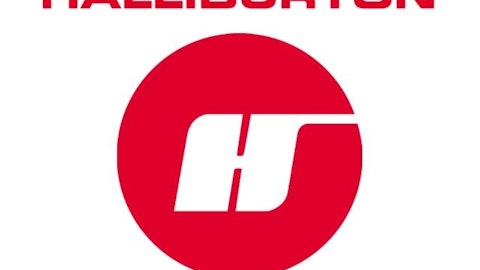Making large gains in the stock market is all about buying businesses with proven management teams in enduring industries. When those businesses can be purchased at valuations equal to or less than projected growth rates, it’s time to back up the truck. Today, energy is the enduring industry, and the stocks of service providers are offering the most tempting discounts to their growth rates.
Higher prices equal higher profits
Low energy prices lead to less demand for exploration and drilling services and vice versa. Prices for these services rise and fall with the level of demand.
From its recent low of $88.73 per barrel reached on April 16, 2013, West Texas Intermediate crude oil has quietly risen to a closing price of $103.46 per barrel this past Friday. This represents a rise of 16.6% in about three months.
Size, safety, and growth at a reasonable price

At first glance, the price-to-earnings multiple on this business, at 16.42 times 2013 consensus earnings, does not appear to be cheap. However, the average projected earnings growth rate for the next five years of 15.7% per year is right in line with the current multiple. If the stock price simply rises along the same trajectory as the earnings growth, investors will receive astonishing returns over this time frame.
Just over five years ago, this stock was selling at a price of $107.43, as energy prices soared to more than $140 per barrel. Schlumberger Limited. (NYSE:SLB) closed this past Friday at only $76.84 per share, representing a 39.8% discount to its high. The stock currently pays a respectable 1.63% dividend, which will produce a bit of income while you wait for its growth-driven capital gains to build over many years.
A smaller size and discount, but still cheap
Halliburton Company (NYSE:HAL) is one of the best-known names in the oil services industry, even though it carries a market capitalization less than half that of Schlumberger Limited. (NYSE:SLB). When it comes to Halliburton, being a smaller business does not mean less profit potential for investors.
Halliburton Company (NYSE:HAL) trades at a price-to-earnings ratio of only 13.95 times the projected 2013 earnings, which represents a 14% discount to its five-year projected annual earnings growth rate of 15.9%. Its stellar reputation in the industry virtually guarantees continued solid growth prospects.
Further supporting the case for future growth are its performance numbers over the past five years, while oil prices have actually declined. In this period, Halliburton Company (NYSE:HAL) has rewarded its long-term shareholders with average annual returns on equity of 19.3%. These would be superb numbers for any business, but are simply stunning for one involved in an industry the world cannot thrive without.
Since its 1.13% dividend yield requires only 19% of its earnings to support, there is also ample opportunity for the company to increase this quarterly payout at any time, which would tend to drive share prices higher. As with Schlumberger Limited. (NYSE:SLB), a share price that simply rises in line with the earnings growth over the coming five years will reward Halliburton Company (NYSE:HAL) investors with world-class annual returns.
Three is not a crowd — it’s another opportunity for big profits
Baker Hughes Incorporated (NYSE:BHI)‘ reach spans at least 80 countries. It has the smallest market capitalization of the three businesses covered here, but there is nothing small about its operating profits of more than $1 billion a year. Best of all, just like our other two examples, it is inexpensively priced for new investors.
With a P/E ratio of only 11.9 times next year’s consensus earnings and an anticipated growth rate of 15% a year for the next five years, the stock price appears to have ample room to rise. At 1.26 times book value, Baker Hughes Incorporated (NYSE:BHI) also trades at less than half the valuation assigned to the other two companies discussed here.
As if any further incentive were needed to open a position in Baker Hughes Incorporated (NYSE:BHI), this stock would have to rise 84% from its current level to equal its 2007 high of over $90/share.
Final thoughts and actions
There is no question that the oil services industry will be with us as long as the world needs fossil fuels to provide for our energy needs. Best of all, these businesses all find themselves at the center of the new American shale oil boom, virtually ensuring continued growth and profits. These new energy fields are projected by some to catapult America to the top of the world’s oil-producing nations in the next five years . The only real question is how much longer these three three key businesses in this arena can remain this cheap.
Investors who act now could easily see 15% annual returns if these share prices only rise fast enough to keep pace with the projected earnings growth. If energy prices continue their recent trend higher, these stocks could explode. For big gains with reduced risk, buy all three.
Ken McGaha has no position in any stocks mentioned. The Motley Fool recommends Halliburton.
The article 3 Stocks for Big Gains in Big Energy originally appeared on Fool.com.
Copyright © 1995 – 2013 The Motley Fool, LLC. All rights reserved. The Motley Fool has a disclosure policy.



